Obsolete denominations of United States currency
The United States has produced several coins and banknotes of its dollar which no longer circulate or have been disused. Many of these were removed for specific reasons such as inflation reducing their value, a lack of demand, or being too similar to another denomination.
Treasury Notes
The U.S. Dollar has numerous discontinued denominations, particularly high denomination bills, issued before and in 1934. Although still legal tender, most are in the hands of collectors and museums. The reverse designs featured abstract scroll-work with ornate denomination identifiers. With the exception of the $100,000 bill, these bills ceased production in the 1940s, and were recalled in 1969. Of these, the $100,000 is an odd bill in that it was printed only as a Series 1934 gold certificate and was only used for internal government transactions. Even though most are in the hands of collectors or museums, they remain legal tender.
| Denomination | Obverse | Reverse | Portrait |
|---|---|---|---|
| $500 bill |  |
 |
William McKinley |
| $1,000 bill | 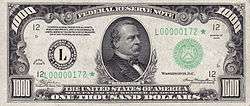 |
 |
Grover Cleveland |
| $5,000 bill |  |
 |
James Madison |
| $10,000 bill | 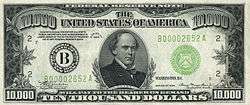 |
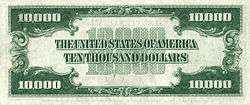 |
Salmon P. Chase |
| $100,000 bill |  |
 |
Woodrow Wilson |
The United States also issued fractional currency for a brief time in the 1860s and 1870s. These are:
- 3 cent note
- 5 cent note
- 10 cent note
- 15 cent note
- 25 cent note
- 50 cent note
Coinage
There have been numerous coins throughout the United States dollar's history that no longer circulate. Some, like the half-cent coin were removed due to inflation reducing their value while others such as the two-cent piece and dollar coin were removed due to a lack of demand.
Note that this table shows the latest status before the coin denomination was rendered obsolete.
| Denomination | Obverse | Reverse | Weight | Diameter | Material | Edge | Issued from |
|---|---|---|---|---|---|---|---|
| Half cent 1/2¢ |
 |
 |
5.443 g | 23.5 mm | 100% Cu | plain | 1793–1857 |
| Two-cent piece 2¢ |
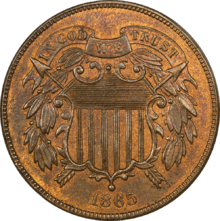 |
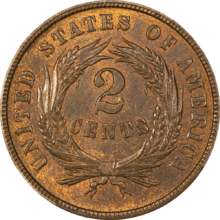 |
6.22 g | 23.00 mm | 95% Cu 5% Sn and Zn |
plain | 1864–1873 |
| Three-cent bronze 3¢ |
 |
 |
10.89 g | 28.57 mm | 95% Cu 5% Zn |
plain | 1863 |
| Three-cent nickel 3¢ |
.jpg) |
.jpg) |
1.94 g | 17.9 mm | 75% Cu 25% Ni |
plain | 1865–1889 |
| Trime 3¢ |
.jpg) |
.jpg) |
.8 g | 14 mm | 90% Ag 10% Cu |
plain | 1851–1873 |
| Half dime 5¢ |
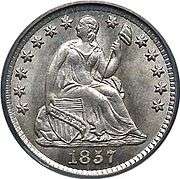 |
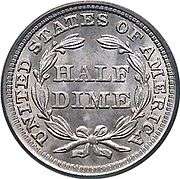 |
1.24 g | 15.5 mm | 90% Ag 10% Cu |
Reeded | 1792–1873 |
| Twenty-cent piece 20¢ |
.jpg) |
.jpg) |
5 g | 22 mm | 90% Ag 10% Cu |
Plain | 1875–1878 |
| Dollar coin $1 |
 |
 |
8.1 g | 26.50 mm | 88.5% Cu 6 % Zn 3.5% Mn 2 % Ni |
Lettered | 1794–2016 |
| Gold dollar $1 |
 |
 |
1.7 g | 14.3 mm | 90% Au 10% Cu |
Reeded | 1849–1889 |
| Quarter eagle $2.50 |
 |
 |
4.18 g | 18 mm | 90% Au 10% Cu |
Reeded | 1795–1929 |
| Three-dollar piece $3 |
 |
 |
5.01 g | 20.5 mm | 90% Au 10% Cu |
Reeded | 1853–1889 |
| Stella $4 |
 |
 |
7.00 g | 22 mm | 6.00g Au 0.30g Ag 0.70g Cu |
Reeded | 1879–1880 |
| Half eagle $5 |
 |
 |
8.36 g | 21.6 mm | 90% Au 10% Cu |
Reeded | 1795–1929 |
| Eagle $10 |
 |
 |
16.7 g | 26.8 mm | 90% Au 10% Cu |
Reeded | 1795–1933 |
| Double eagle $20 |
 |
 |
35 g | 34 mm | 90% Au 10% Cu |
Reeded | 1849–1929, 2009 |
| Half-union $50 |
_Obverse.jpg) |
_Reverse.jpg) |
83.58 g | 50.80 mm | 90% Au 10% Cu |
Reeded | 1877 (pattern) 1915 (commemorative) |